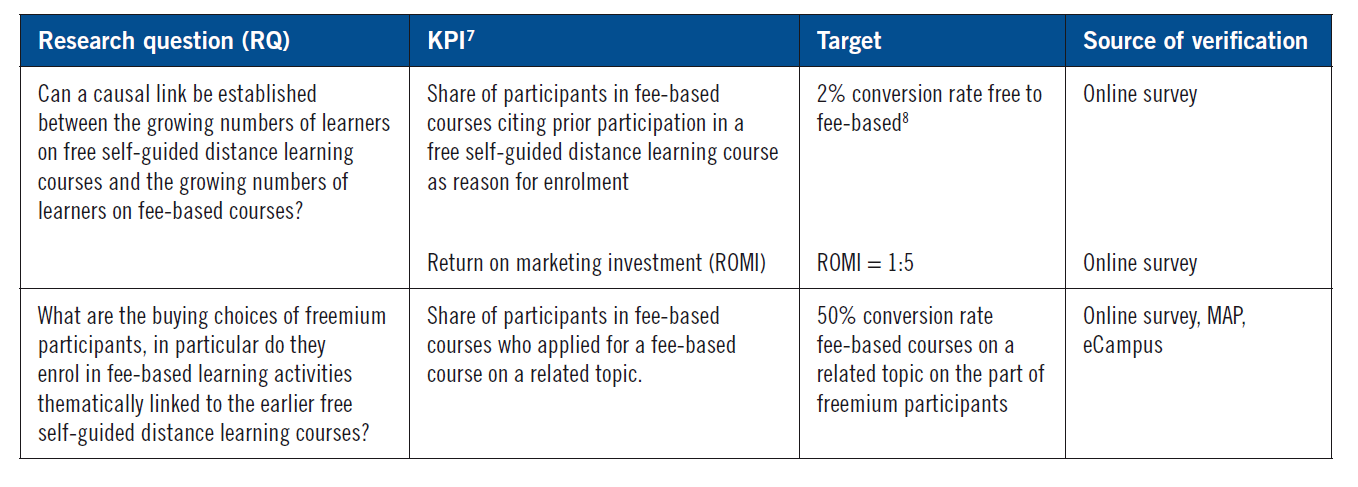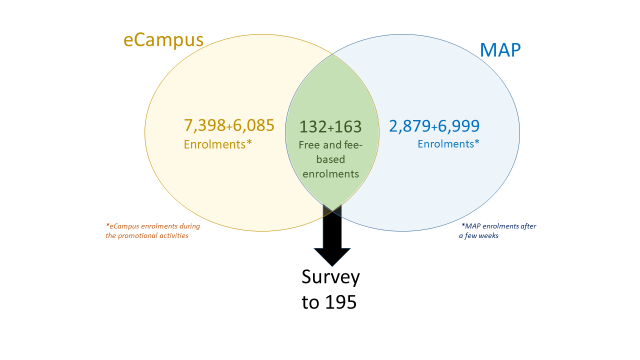DATA-DRIVEN SERVICES TO INCREASE THE TRAINING OUTREACH OF THE CENTRE BY PROMOTING FREE SELF-GUIDED DISTANCE LEARNING COURSES
Paper Brief
Data-driven services to increase the training outreach of the centre by promoting free self-guided distance learning courses
Study of freemium participants
Introduction
This article provides an in-depth study of two experiments conducted to investigate the connection between participants in free and fee-based courses, their characteristics, and the potential return on investment. The experiments aimed to determine the effectiveness of digital marketing in increasing the uptake of free self-guided distance learning courses and whether there is a causal link between the growing numbers of learners in free courses and enrollment in fee-based courses. Additionally, the study examined the impact of using a marketing funnel system to promote free courses and extend training outreach.
Overview and References to the Main Experiments
The experiments were conducted as part of a biennial work plan and focused on two previous experiments. The first experiment aimed to answer three research questions related to the potential of digital marketing to increase the uptake of free courses, the impact of targeting learners with similar characteristics to past learners, and the causal link between free and fee-based course enrollment. The second experiment investigated the effectiveness of using a marketing funnel system to promote selected free courses through various channels.
Objectives of the Study
The overall objective of the study was to contribute to the ITCILO Programme and Budget 2022-23 by strengthening the Training Department's Technical Programmes' capacity to reach a larger audience. The immediate objective was to study the causal link between free and fee-based course participants reached through marketing data analytics.
Scope
The analysis focused on freemium participants who first enrolled in free self-guided distance learning courses and later enrolled in fee-based courses. The study specifically considered participants who enrolled as a direct result of digital marketing campaigns conducted via Facebook, LinkedIn, and email. The emphasis was on boosting outreach through data analytics rather than income generation.
During Experiment 1, the study considered the participants enrolled on the following free self-guided distance learning courses:
During Experiment 2, the courses concerned were:
Research Framework
The experiment sought answers to two research questions (RQs):
- RQ 1: Is there a causal link between the growing numbers of learners on free self-guided distance learning courses and the growing numbers on fee-based courses?
- RQ 2: What are the buying choices of freemium participants, in particular do they enrol on fee-based learning activities thematically linked to earlier free self-guided distance learning cours

Description of the Participant Sample
The analysis involved two participant samples, corresponding to the two experiments. The first experiment included 7,398 new enrolments in free self-guided distance learning courses, while the second experiment involved 6,085 new enrolments. Survey questionnaires were sent to a subset of participants who enrolled in the free courses promoted and later in a fee-based course to gather additional data on their sources of information and exclude non-freemium participants.

Findings
RQ 1: THE CAUSAL LINK BETWEEN LEARNERS ON FREE SELF-GUIDED DISTANCE LEARNING COURSES AND FEE-BASED COURSES
Regarding the causal link between learners in free and fee-based courses, the study found a conversion rate of 2% from free to fee-based courses. Social media campaigns were identified as the most effective channel for generating leads for free courses. The return on investment (ROMI) for the experiments was calculated, indicating a potential increase in fee-based course enrollments.

RQ 2: THE BUYING CHOICES OF FREEMIUM PARTICIPANTS: ENROLMENT IN FEE-BASED LEARNING ACTIVITIES THEMATICALLY LINKED TO AN EARLIER FREE SELF-GUIDED DISTANCE LEARNING COURSE
Regarding the buying choices of freemium participants, it was observed that most participants enrolled in fee-based courses in different thematic areas rather than related topics.
As the flow charts below show, interest in the course topics was very “holistic”: in other words, many participants in free self-guided courses subsequently enrolled for fee-based courses in different areas of expertise
Experiment 1
Source: https://public.flourish.studio/visualisation/13821406/
In the case of Experiment 1, of the 132 freemium participants identified (those who first enrolled for a free course and then for a fee-based course), 115 were taken into account for the purposes of this analysis:
- 45 who first enrolled on the free SG course “Business and Decent work” (SEE)
- 50 who first enrolled on the free SG course “Introduction to ILS” (ILSGEN)
- 20 who first enrolled on the free SG course “Introduction to PCM” (ODPS)
Experiment 2
Source: https://public.flourish.studio/visualisation/13891560/
In the case of Experiment 2, of the 163 freemium participants identified (those who first enrolled in a free course and then in a fee-based course) 126 were taken into account for the purposes of this analysis:
- 14 who first enrolled on the course “CLE 1 – Introduction to ILS” (ILSGEN)
- 7 who first enrolled on the course “Social Dialogue and Industrial relations: a self-guided induction course” (SPGT)
- 53 who first enrolled on the course “Introduction to PCM” (ODPS)
- 12 who first enrolled on the course “The future of work in the rural economy” (SEE)
- 17 who first enrolled on the course “Digital Facilitation in Synchronous Events” (LIP)
- 5 who first enrolled on the course “MOOC on Quality Apprenticeships” (EPAP)
- 18 who first enrolled on the course “Trade Union eLearning course on UNSDCF and the Decent Work Agenda” (ACTRAV)
Free self-guided distance learning courses proved to be an effective channel for making participants aware of various training opportunities among the ITCILO courses.
Conclusions and Recommendations
The study concluded that promoting free self-guided distance learning courses can extend the outreach of both free and fee-based courses. It also highlighted the importance of engaging participants via email and recommended leveraging the CRM contacts to promote free courses and the entire course portfolio. Additionally, maintaining the quality of free self-guided distance learning courses was emphasized.
The article concludes with recommendations for future experiments, including studying the flow from free to fee-based courses over a longer period and incorporating participant preferences into the evaluation questionnaire. The aim is to further enhance the effectiveness of marketing strategies and expand the reach of ITCILO's training activities.
Original paper by:









